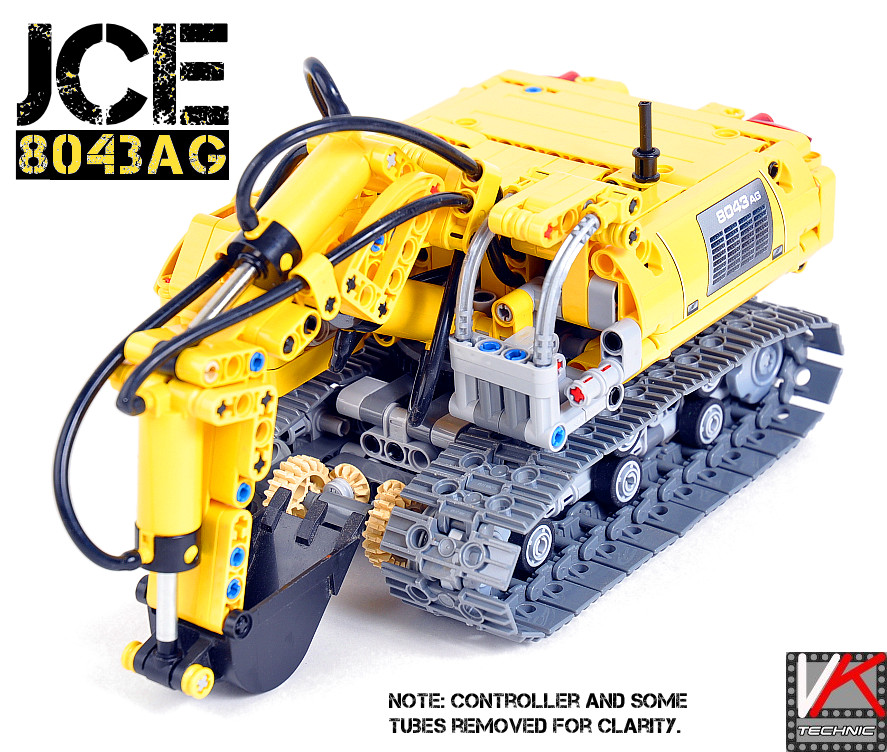My second excavator model, this time built with a strong focus on size (or lack thereof). Controlled by an external controller.
Datasheet
Completion Date: 8/15/2011
Power Source: Electric (Power Functions 8878 Rechargeable Battery) / Pneumatic (Manual pump / Internal Compressor)
Dimensions (with arm in folded position, excluding controller & tubing): 28x15x17 studs / 8.5x4.75x5 inches
Weight (without controller): 587g
Drive motors: 2x M-Motors (one for each track)
Total motors: 4x M-Motors
Completion Date: 8/15/2011
Power Source: Electric (Power Functions 8878 Rechargeable Battery) / Pneumatic (Manual pump / Internal Compressor)
Dimensions (with arm in folded position, excluding controller & tubing): 28x15x17 studs / 8.5x4.75x5 inches
Weight (without controller): 587g
Drive motors: 2x M-Motors (one for each track)
Total motors: 4x M-Motors
This model of an excavator was slightly inspired by the 8043 (hence the label), and its control system was inspired by Jennifer Clark. The focus here was to build the smallest fully functional excavator with an internal compressor. The excavator itself turned out excellent, but the controller, as you will see later, turned out to be huge.
The excavator's chassis was based on the MST001 “Mosquito” which was built earlier this month. The chassis was improved in many ways. First of all, the tracks were shortened by 5 links each, a turntable was added, more return rollers and road wheels were added, and tires were added on the road wheels and return rollers for slightly fatter tracks.
The body itself was built around two 5x7 frame pieces and some 3x11 slope panels. Inside, there is a compressor and the slewing motor. Unfortunately, the compressor did not work efficiently as the pneumatic hoses were pressing against the top of the superstructure as the superstructure itself is only 5 studs tall.
The excavator's chassis was based on the MST001 “Mosquito” which was built earlier this month. The chassis was improved in many ways. First of all, the tracks were shortened by 5 links each, a turntable was added, more return rollers and road wheels were added, and tires were added on the road wheels and return rollers for slightly fatter tracks.
The body itself was built around two 5x7 frame pieces and some 3x11 slope panels. Inside, there is a compressor and the slewing motor. Unfortunately, the compressor did not work efficiently as the pneumatic hoses were pressing against the top of the superstructure as the superstructure itself is only 5 studs tall.
Three pneumatic cylinders control the excavator's arm – one for the boom, one for the dipper, and one for the bucket. Due to the design, the dipper can actually bend backwards about 25 degrees...
The controller was quite possibly the most complex part of the excavator. It contained the battery box, two PF switches, one IR Receiver, two PF IR Remotes, four pneumatic switches, and a manual pump. Originally, I was intending on borrowing two more PF switches to use for the controller, but I got impatient and replaced it with an IR Receiver and two remotes. All in all, there were 7 pneumatic hoses and 4 PF wires connecting the excavator and its controller. Because of this, I had a severe shortage of pneumatic tubing, resulting in the extremely small distance between the two seen below.
On the controller, three pneumatic switches controlled the arm, the remotes controlled the drive, one of the PF switches controlled slewing, the other controlled the compressor, and one pneumatic switch switched between air inputs (compressor or manual pump). Confusing, huh?
Due to the model being very light, there was no need for excessive gear reduction after the motors, resulting in much faster motor operation. This was done both to conserve space and because there really was no need to.
All in all, I am very pleased with how this build turned out, but perhaps replacing the internal compressor with the battery box and mounting the pneumatic switches in the hull as Sariel did in his LiebherrR944C would have yielded better results (not to mention a tidier and smaller controller). The arm could have used a bit more “skinning,” but other than that the excavator is a huge improvement both aesthetically and function-wise from my first excavator.
EDIT: After disassembling the excavator, I found the compressor's true problem -- one of the small pumps was leaking air.
More photos
Video:
All in all, I am very pleased with how this build turned out, but perhaps replacing the internal compressor with the battery box and mounting the pneumatic switches in the hull as Sariel did in his LiebherrR944C would have yielded better results (not to mention a tidier and smaller controller). The arm could have used a bit more “skinning,” but other than that the excavator is a huge improvement both aesthetically and function-wise from my first excavator.
EDIT: After disassembling the excavator, I found the compressor's true problem -- one of the small pumps was leaking air.
More photos
Video:






Is there any further reading you would recommend on this?
ReplyDeleteAmela
pneumatic switch